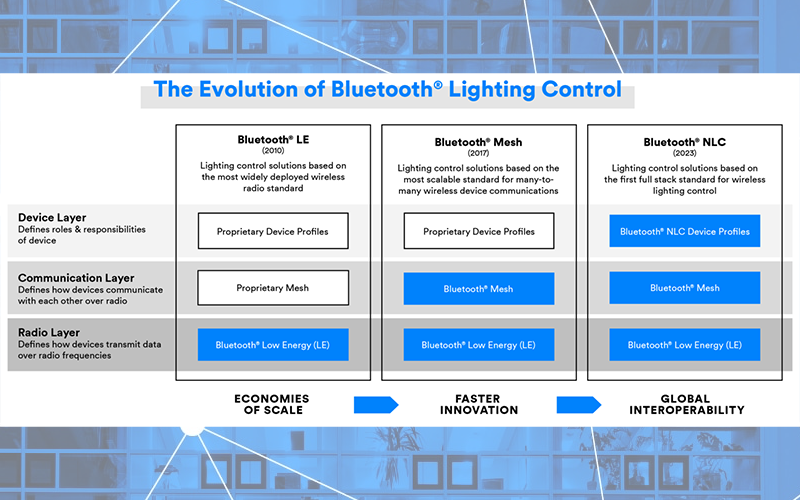Introducing Bluetooth NLC – A Milestone in the Interoperability Journey
The Bluetooth Special Interest Group (SIG) recently announced its full-stack standard for wireless lighting control, Bluetooth Networked Lighting Control (NLC). Specifically designed to meet the scale, reliability, and security demands required in commercial settings, Bluetooth® NLC enables multi-vendor interoperable wireless lighting control systems and unlocks the potential for mass adoption of wireless lighting control.
The benefits of standardization are well documented and illustrated. With standardization comes interoperability, and with interoperability comes trust – trust that products from different manufacturers can work together seamlessly, making it easier to combine products from multiple manufacturers to create fit-for-purpose, value-added systems. Standardization also helps reduce the costs of development, expand the overall size of the market, and encourage innovation by allowing manufacturers to focus their engineering efforts on higher-level, value-added capabilities.
Developing standards to enable interoperability is at the heart of the Bluetooth SIG’s mission. But it is not a binary one-time event. Interoperability is a mindset and a journey.
Standardizing Wireless Lighting Control
In the lighting industry, for instance, the potential for greater design flexibility, lower cost of implementation, and the increased future extensibility offered by wireless lighting control solutions began to pique the market’s interest over a decade ago. However, the lack of a wireless standard presented a barrier to adoption, and leaders across the industry turned to Bluetooth® technology to light the path to standardization.
First, the industry standardized on the wireless radio, Bluetooth Low Energy (LE), bringing much-needed economies of scale that only the most widely deployed wireless radio standard in the world can provide.
The next step was the release of Bluetooth® Mesh in 2017. Bluetooth Mesh technology provides a rich set of features and options to enable the creation of large-scale device networks. Bluetooth® Mesh alleviates the burden of proprietary mesh development and increases innovation by freeing manufacturers’ engineering teams to turn their attention to the development of more value-added, differentiating features and capabilities. This has helped Bluetooth Mesh establish itself as the preferred wireless technology for scalable commercial and industrial IoT applications.
However, the optional nature of Bluetooth Mesh features can cause challenges for implementers when they must decide which options to choose for their chosen product segments. If vendors operating in the same product segments choose a different set of options that do not work well with other peer products (e.g., mesh features chosen for light bulbs are not compatible with features selected for light switches), a situation can arise where product ecosystems do not interoperate, which degrades the user experience.
To address this challenge, the Bluetooth SIG developed a new class of specifications called Bluetooth Mesh Device Profiles.
Lighting Control Device Profiles
Device Profiles define which options and features of the Bluetooth Mesh specifications are mandatory for a certain kind of end product. The first suite of mesh device profiles, collectively referred to as NLC profiles, build on Bluetooth Mesh to enable the world’s first full-stack, multi-vendor interoperable wireless standard for wireless lighting control, Bluetooth® NLC.
The figure summarizes the Bluetooth lighting control journey towards interoperability and highlights how Bluetooth® NLC enables true multi-vendor interoperability.
Ensuring global interoperability requires standardization across all three layers of a wireless lighting control solution – the radio layer, communication layer, and device layer. Before Bluetooth® NLC, a wireless standard to define functionality at the device layer did not exist, limiting global mainstream adoption and preventing the market from reaching its full potential. Bluetooth® Networked Lighting Control (NLC) solves this challenge. By offering standardization from the radio through the device layer, Bluetooth NLC enables true multi-vendor interoperability and mass adoption of wireless lighting control.
Learn more about Bluetooth Networked Lighting Control.
© 2023 Luger Research e.U. – Institute for Innovation & Technology

